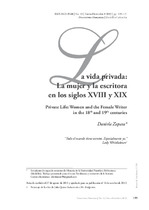| dc.contributor.author | Zapata, Daniela | |
| dc.coverage.spatial | Seccional Medellín | spa |
| dc.date.accessioned | 2021-02-08T17:19:33Z | |
| dc.date.available | 2021-02-08T17:19:33Z | |
| dc.date.issued | 2013 | |
| dc.identifier.uri | http://hdl.handle.net/20.500.11912/7960 | |
| dc.description | p. 109 - 121 | spa |
| dc.description.abstract | Cuando nos preguntamos por la escritora, es decir, por la mujer que tuvo la osadía de tomar la pluma y describir todo su entorno: sus sufrimientos, la sociedad en la que se veía sumergida, los anhelos perdidos y los ideales a los que aspiraba, también tenemos que preguntarnos por el espacio donde fue posible la escritura. En la época moderna donde las restricciones eran casi palpables, la figura de la mujer se podía observar en dos escenarios diferentes. La vida pública y la vida privada se manifiestan así, para justificar la necesidad de escribir, una necesidad que se hacía más angustiante por las convenciones y prohibiciones que debían cumplirse debidamente. Mientras el espacio de lo público hacía referencia a las posibilidades limitadas de las mujeres que se reducían a buscar un matrimonio adecuado y cumplir los deberes como esposa y como madre, muchas de ellas encontraran en el silencio y en la soledad de su habitación –cámara privada-, cabinet, escritorio o secreter- la posibilidad de escribir. | spa |
| dc.description.abstract | When we ask about the female writer, that is, about the woman who had the audacity to take a pen and describe her surroundings: her sufferings, the society in which she was submerged, her lost hopes and the ideals to which she aspired, we also have to ask ourselves about the setting where writing was made possible. In the modern era, when restrictions were almost tangible, the figure of the woman could be seen in two different scenarios. Public life and private life manifest themselves in such a way as to justify the need to write, a need that became distressing because of the conventions and prohibitions which had to be followed properly. The public space makes reference to women’s limited possibilities such as entering a suitable marriage and duly performing a wife´s and mother´s duties. On the other hand, many women found in the silence and solitude of their rooms and private chambers, a desk, escritoire or bureau which gave them the possibility to write. | spa |
| dc.format.mimetype | application/pdf | |
| dc.language.iso | spa | |
| dc.publisher | Universidad Pontificia Bolivariana | spa |
| dc.relation.ispartof | Pensamiento humanista | spa |
| dc.rights | Attribution-NonCommercial-NoDerivatives 4.0 International | * |
| dc.rights.uri | http://creativecommons.org/licenses/by-nc-nd/4.0/ | * |
| dc.subject | Mujer | spa |
| dc.subject | Escritora | spa |
| dc.subject | Austen | spa |
| dc.subject | Privado | spa |
| dc.subject | Secretos | spa |
| dc.subject | Woman | spa |
| dc.subject | Writer | spa |
| dc.subject | Austen | spa |
| dc.subject | Privacy | spa |
| dc.subject | Secrets | spa |
| dc.title | La vida privada: La mujer y la escritora en los siglos XVIII y XIX | spa |
| dc.title.alternative | Private Life: Women and the Female Writer in the 18th and 19th centuries | spa |
| dc.type | article | spa |
| dc.rights.accessRights | openAccess | spa |
| dc.type.hasVersion | publishedVersion | spa |
| dc.description.sectional | Medellín | spa |
| dc.identifier.instname | instname:Universidad Pontificia Bolivariana | spa |
| dc.identifier.reponame | reponame:Repositorio Institucional de la Universidad Pontificia Bolivariana | spa |
| dc.identifier.repourl | repourl:https://repository.unab.edu.co/ | |


